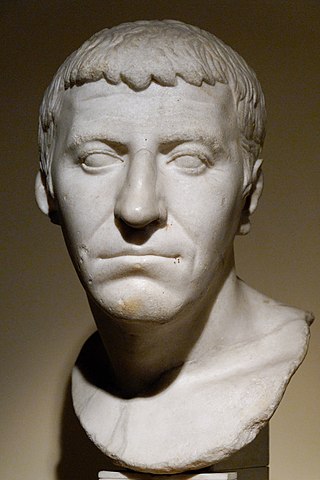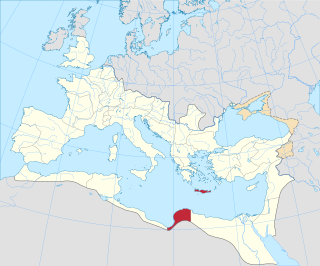Related Research Articles

Ptolemy Apion or simply known as Apion was the last Greek King of Cyrenaica who separated it from the Ptolemaic Kingdom of Egypt, and in his last will bequeathed his country to Rome. He was a member of the Ptolemaic dynasty.

Legio XIV Gemina was a legion of the Imperial Roman army, levied by Julius Caesar in 57 BC. The cognomen Gemina (Twinned) was added when the legion was combined with another understrengthed legion after the Battle of Actium. The cognomen Martia Victrix was added following their service in the Pannonian War c. AD 9 and the defeat of Boudicca in AD 61. The emblem of the legion was the Capricorn, as with many of the legions levied by Caesar.

Legio I Adiutrix, was a legion of the Imperial Roman army founded in AD 68, probably by Nero or Galba when he rebelled against emperor Nero. The last record mentioning the Adiutrix is in 344, when it was stationed at Brigetio, in the Roman province of Pannonia. The emblem of the legion was a capricorn, used along with the winged horse Pegasus, on the helmets the symbol used by I Adiutrix legionaries was a dolphin.
Legio XXI Rapax was a legion of the Imperial Roman army. The symbol of the legion is thought to have been a capricorn.

The Revolt of the Batavi took place in the Roman province of Germania Inferior between AD 69 and 70. It was an uprising against the Roman Empire started by the Batavi, a small but militarily powerful Germanic tribe that inhabited Batavia, on the delta of the river Rhine. They were soon joined by the Celtic tribes from Gallia Belgica and some Germanic tribes.

Legio I Parthica was a legion of the Imperial Roman army founded in AD 197 by the emperor Septimius Severus for his forthcoming war against Parthia. The legion's presence in the Middle East is recorded until the early 5th century.

Gnaeus Domitius Corbulo was a popular Roman general, brother-in-law of the emperor Caligula and father-in-law of Domitian. The emperor Nero, highly fearful of Corbulo's reputation, ordered him to commit suicide, which the general carried out faithfully, exclaiming "Axios", meaning "I am worthy", and fell on his own sword.

Gaius Claudius Nero was a Roman general active during the Second Punic War against the invading Carthaginian force, led by Hannibal Barca. During a military career that began as legate in 214 BC, he was praetor in 212 BC, propraetor in 211 BC during the siege of Capua, before being sent to Spain that same year. He became consul in 207 BC.

Lusius Quietus was a Roman Berber general and 11th legate of Judaea from 117. He was the principal commander against the Jewish rebellion known as the Kitos War. As both a general and a highly acclaimed commander, he was notably one of the most accomplished Berber statesmen in ancient Roman history. After the death of the emperor Trajan, Quietus was murdered or executed, possibly on the orders of Trajan's successor Hadrian.

The first Battle of Herdonia was fought in 212 BC during the Second Punic War between Hannibal's Carthaginian army and Roman forces led by Praetor Gnaeus Fulvius Flaccus, brother of the consul Quintus Fulvius Flaccus. The Roman army was destroyed, leaving Apulia free of Romans for the year.

The second battle of Herdonia took place in 210 BC during the Second Punic War. Hannibal, leader of the Carthaginians, who had invaded Italy eight years earlier, encircled and destroyed a Roman army which was operating against his allies in Apulia. The heavy defeat increased the war's burden on Rome and, piled on previous military disasters, aggravated the relations with her exhausted Italian allies. For Hannibal the battle was a tactical success, but did not halt for long the Roman advance. Within the next three years the Romans reconquered most of the territories and cities lost at the beginning of the war and pushed the Carthaginian general to the southwestern end of the Apennine peninsula. The battle was the last Carthaginian victory of the war; all battles which followed were either inconclusive or Roman victories.

The First Battle of Capua was fought in 212 BC between Hannibal and two Roman consular armies. The Roman force was led by two consuls, Quintus Fulvius Flaccus and Appius Claudius Pulcher. The Roman force was defeated, but managed to escape. Hannibal temporarily managed to raise the siege of Capua. A tactical Carthaginian victory, it ultimately did not help the Capuans.

The Battle of the Silarus was fought in 212 BC between Hannibal's army and a Roman force led by centurion Marcus Centenius Penula. The Carthaginians were victorious, destroying the entire Roman army and killing 15,000 Roman soldiers in the process.

Islamic rule in Tripolitania and Cyrenaica began as early as the 7th century. With tenuous Byzantine control over Libya restricted to a few poorly defended coastal strongholds, the Arab invaders who first crossed into Pentapolis, Cyrenaica in September 642 encountered little resistance. Under the command of Amr ibn al-A'as, the armies of Islam conquered Cyrenaica, renaming the Pentapolis, Barqa.
Hanno, distinguished as the son of the suffet Bomilcar, was a Carthaginian officer in the Second Punic War.

The Battle of Canusium also known as the Battle of Asculum was a three-day engagement between the forces of Rome and Carthage. It took place in Apulia during the spring of 209 BC, the tenth year of the Second Punic War. A larger Roman offensive, of which it was a part, aimed to subjugate and to punish cities and tribes that had abandoned the alliance with Rome after the Battle of Cannae, and to narrow the base of the Carthaginian leader, Hannibal, in southern Italy.

Crete and Cyrenaica was a senatorial province of the Roman Republic and later the Roman Empire, established in 67 BC, which included the island of Crete and the region of Cyrenaica in modern-day Libya. These areas were settled by Greek colonists from the eighth to sixth centuries BC. After Alexander the Great's death, his short-lived empire was partitioned between his generals during the Wars of the Diadochi. Cyrenaica ended up under Egyptian rule, except for Crete, which remained independent.

The area of North Africa which has been known as Libya since 1911 was under Roman domination between 146 BC and 672 AD. The Latin name Libya at the time referred to the continent of Africa in general. What is now coastal Libya was known as Tripolitania and Pentapolis, divided between the Africa province in the west, and Crete and Cyrenaica in the east. In 296 AD, the Emperor Diocletian separated the administration of Crete from Cyrenaica and in the latter formed the new provinces of "Upper Libya" and "Lower Libya", using the term Libya as a political state for the first time in history.
The Nasamones were a nomadic Berber tribe inhabiting southeast Libya. They were believed to be a Numidian people, along with the Garamantes they hunted Troglodytae referred to as Arabs of south. They had established their tribe with their important leaders as rulers and they had a sphere of influence from Siwa Oasis to the Gulf of Sitre.

The gens Norbana was a plebeian family at ancient Rome. Members of this gens are first mentioned toward the beginning of the first century BC, and from then to the end of the second century AD they filled a number of magistracies and other important posts, first in the late Republic, and subsequently under the emperors.
References
- ↑ "The Nasamones of Awjila". livius.org. Livius. Retrieved 20 January 2015.